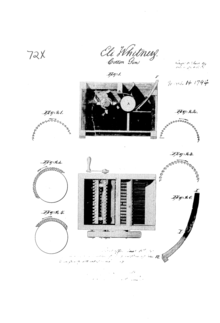Patent model

A patent model was a handmade miniature model no larger than 12" by 12" by 12" (approximately 30 cm by 30 cm by 30 cm) that showed how an invention works. It was one of the most interesting early features of the United States patent system.[1]
Since some early inventors had little technological or legal training, it was difficult for them to submit formal patent applications which require the novel features of an invention to be described in a written application and a number of diagrams.
History
In the US, patent models were required from 1790 to 1880.[2] The United States Congress abolished the legal requirement for them in 1870, but the U.S. Patent Office (USPTO) kept the requirement until 1880.[3]
On July 31, 1790 inventor Samuel Hopkins of Pittsford, Vermont became the first person to be issued a patent in the United States. His patented invention was an improvement in the "making of Pot Ash by a new apparatus & process." These earliest patent law required that a working model of each invention be produced in miniature.
Some inventors still willingly submitted models at the turn of the twentieth century. In some cases, an inventor may still want to present a "working model" as an evidence to prove actual reduction to practice in an interference proceeding. In some jurisdictions patent models stayed an aid to demonstrate the operation of the invention. In applications involving genetics, samples of genetic material or DNA sequences may be required.
History of the United States Patent Office's collection of models
The United States Patent Office used to publicly display the models of approved patents.[4]
The United States Patent Office's collection of models have suffered two major fires- one in 1836, and another in 1877. The 1877 fire destroyed 76,000 patent models.[5]
The models were sold off by the patent office in 1925 and were purchased by Sir Henry Wellcome, the founder of the Burroughs-Wellcome Company (now part of GlaxoSmithKline). Although he intended to establish a patent model museum, the stock market crash of 1929 damaged his fortune; the models were left in storage. After his death, the collection went through a number of ownership changes; a large portion of the collection—along with $1,000,000—was donated to the nonprofit United States Patent Model Foundation by Cliff Peterson. Rather than being put into a museum, these models were slowly sold off by the foundation. A saga of legal wrangling, purchasing, and re-selling ensued.[6] A comparatively small number of models(4,000) were the property property of the Rothschild Patent Museum until 2015, when they were they were transferred to Hagley Museum and Library, and now form a part of the museums collection of patent models.[1][6][7]
See also
- United States Patent and Trademark Office
- Patent drawing
- 1836 U.S. Patent Office fire
- 1877 U.S. Patent Office fire
References
- 1 2 Byers, Kim. Patent Models: Icons of Innovation, USPTO, February 11, 2002. Retrieved September 11, 2010.
- ↑ Riordan, Teresa. Patent Models' Strange Odyssey, New York Times, February 18, 2002.
- ↑ A Simple Fix for the US Patent System: The Legal Requirement For Working Models, KeelyNet website. Retrieved September 12, 2010.
- ↑ Old Patent Office
- ↑ Timeline of the USPTO Patent Model Collection
- 1 2 PatentModel website
- ↑ Hagley Museum and Library press release
Further reading
- Hughes, Debra K., Martin W. Kane, and Charles A. Foote. Artifacts of invention: Patent models at the Hagley Museum and Library. York, Pa: York Graphic Services, 1993.
- Janssen, Barbara Suit. Patent Models Index: Guide to the Collections of the National Museum of American History, Smithsonian Institution. Smithsonian Contributions to History and Technology, no. 54. Washington, D.C.: Smithsonian Institution Scholarly Press, 2010. (A complete, full-color, 2-volume index of the more than 10,000 original patent models now housed in the collections of the Smithsonian's National Museum of American History.)
- Rothschild, Alan, and Ann Rothschild. Inventing a Better Mousetrap: 200 Years of American History in the Amazing World of Patent Models. 2015.
External links
| Wikimedia Commons has media related to Patent models. |
- The Rothschild Petersen Patent Model Museum
- The patent model of Alexander Graham Bell's No. 174,465 invention
- Patent model windmill c.1860-70
- Press release by Hagley Museum and Library
- Hagley Museum and Libary's online database of museum objects